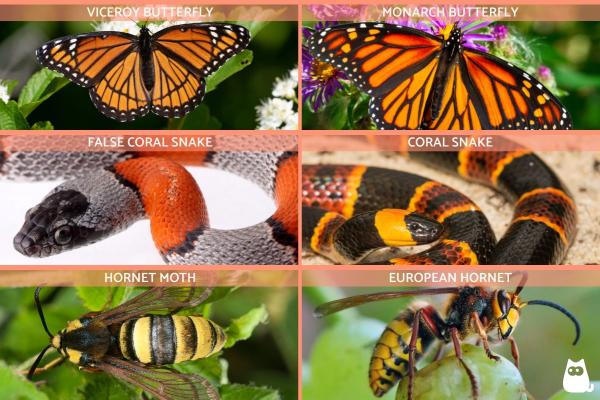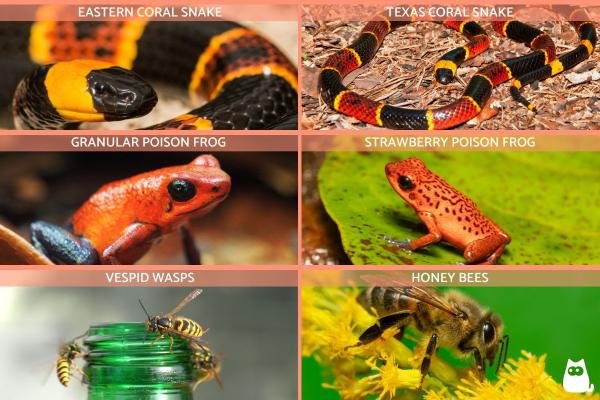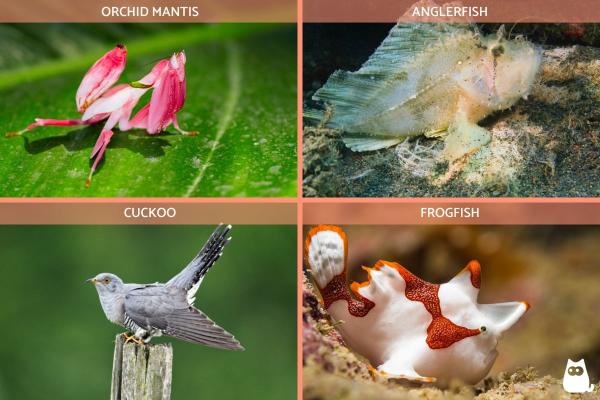
Picture yourself in a garden, spotting what looks like a venomous coral snake. But on closer inspection, it turns out to be a harmless milk snake. This phenomenon, called mimicry, is one of evolution's most ingenious survival tactics. In nature, organisms have evolved to imitate not just the appearance of other species, but also their behaviors, scents, and even sounds, creating complete impersonations.
In the following AnimalWised article, we explore what mimicry is, its diverse types and providing illustrative examples.
What is animal mimicry?
Mimicry represents one of evolution's most sophisticated solutions to survival challenges, emerging independently across vastly different species and environments. When we examine mimicry closely, we discover it's not just about visual resemblance, it's a complex interplay of signals that can involve shape, color, behavior, movement patterns, chemical signatures, and even sounds.
This evolutionary strategy works because living organisms are constantly sending and receiving signals in their environment. These signals trigger specific neural pathways and behavioral responses that have evolved over millions of years. Mimicry exploits these existing communication channels, essentially "hacking" the sensory and response systems that other organisms have developed.
The precision with which mimicry evolves highlights the power of natural selection. Consider that organisms must evolve not just to look like another species, but to trigger very specific behavioral responses in their targets. This requires changes across multiple biological systems, from pigment production to muscle structure to behavioral patterns. What makes this even more impressive is that these changes must occur in a coordinated way to create a convincing illusion.
The effectiveness of mimicry also reveals important insights about perception and behavior in nature. For mimicry to work, the target species must have specific, predictable responses to certain signals. This tells us that many animal behaviors are hardwired rather than learned.
From an evolutionary perspective, mimicry demonstrates how indirect selection pressures can shape species development. The mimic doesn't just evolve in response to direct environmental pressures, but in response to how other organisms perceive and react to signals in their environment. This creates complex evolutionary feedback loops where changes in one species can drive changes in others.
What is the difference between camouflage and mimicry?
Mimicry and camouflage are two very different ways organisms use visuals for deception. Both change how an organism looks, but they work on different principles and help in different ways.
Mimicry is when an organism evolves to look like another specific organism. It's like biological impersonation, taking advantage of existing relationships in the environment. The mimic actively copies features that make the model recognizable, often becoming more noticeable to do so.
Camouflage, on the other hand, is about blending in with the general background of the environment to become less detectable. It's about disappearing, not impersonating. The evolutionary pressure here is to break up recognizable outlines and merge with environmental patterns, not to copy another organism. This means different adaptations: instead of specific markings like mimics, camouflaged species often have variable patterns and colors that disrupt their outline.
The biology behind these strategies is also different. Camouflage often involves specialized cells called chromatophores that can change color or pattern to match the background. Mimicry usually relies on fixed patterns that have evolved over generations to match specific model species. This difference affects predator-prey dynamics and evolutionary arms races.
Finally, these strategies face different pressures. A mimic's success depends on its model species continuing to exist and be recognized. A camouflaged species needs to keep up with changes in its habitat's appearance. Discover more about the science behind these different survival tactics in our related article.
Types of animal mimicry
At its core, mimicry involves communication through either signals or cues. Signals are traits or behaviors that evolved specifically for communication, while cues are features that provide information but didn't evolve for that purpose. Knowing this helps us understand how different types of mimicry work in nature.
In other words, we can divide mimicry into two main types based on how the mimic, the thing it copies (the model), and the receiver interact.
- Signal mimicry occurs when the mimic and the model share the same audience. For example, a harmless butterfly mimicking a poisonous butterfly to deceive the same bird predator.
- Cue mimicry occurs when the mimic and the model target different audiences. For instance, a praying mantis resembling a flower to lure insects as prey. In this case, the flower’s intended audience is pollinators, not prey.
We can further classify these interactions into four main categories. Each type depends on two things: whether the communication is honest or not, and how the mimic and the other species benefit or lose. These two things create four different kinds of mimicry:
- Müllerian mimicry: this employs an honest signal of danger, where the warning of being dangerous is truthful.
- Batesian mimicry: this involves a deceptive signal of danger, where the mimic falsely claims it is dangerous.
- Aggressive mimicry: this involves a deceptive signal of helpfulness, where the mimic falsely claims it is helpful.
- Rewarding mimicry: this employs an honest signal of helpfulness, where the claim of being helpful is truthful.
Müllerian mimicry
In Müllerian mimicry, two or more dangerous species share the same warning signals. Think of wasps and bees, they both have black and yellow stripes, and they can both sting. When a predator learns to avoid one, it automatically avoids the other too. The warning signals go beyond just colors. Some species share sounds (like warning buzzes), smells (like bitter chemicals), or behaviors (like specific flight patterns).
This helps all species involved. Each time a predator meets any one of these animals and gets hurt, it learns to avoid all of them. The predator benefits too, it only needs to learn one warning pattern instead of many. Scientists call this a mutualistic relationship because all species benefit from sharing the same warning pattern.
Unlike other forms of mimicry, Müllerian mimicry involves honest signals. When an animal shows these warning patterns, it really can defend itself. These warning signals often use bright, easy-to-spot patterns called aposematic coloration, the opposite strategy from camouflage.
The strength of this protection increases with numbers. The more dangerous species share a warning pattern, the more quickly predators learn to avoid it. This creates evolutionary pressure for similar dangerous species to converge on the same warning signals over time. For example, several species of toxic butterflies in South America share similar wing patterns, creating large "mimicry rings" where multiple species copy each other.
Examples of Müllerian mimicry:
- Eastern coral snake (Micrurus fulvius) and Texas coral snake (Micrurus tener) both display red, yellow, and black bands and possess deadly venom.
- The granular poison frog (Oophaga granulifera) and strawberry poison frog (Oophaga pumilio) both display bright red bodies with black spots.
- Vespid wasps (family Vespidae) and honey bees (Apis mellifera) share black and yellow striped patterns and can sting predators.
Ever wondered why poisonous animals often wear such bright colors? Discover nature's warning signals in our other article.

Batesian mimicry
Unlike Müllerian mimicry, Batesian mimicry involves deception through costly signals. Named after Henry Walter Bates, this strategy occurs when harmless species evolve to resemble dangerous ones.
In other words, the mimics develop features that trigger the same threat recognition systems in predators that dangerous species activate. This can include matching specific color patterns, body shapes, movements, behaviors, and even chemical signatures. The deception must be convincing enough to activate the predator's learned or innate avoidance responses that would normally protect them from genuinely dangerous species.
This form of mimicry succeeds only when the harmless mimic remains relatively rare compared to its model. This requirement exists because Batesian mimicry exploits predator learning and memory. Every time a predator encounters a harmless mimic instead of the dangerous model, it weakens the predator's learned association between the warning signals and actual danger. Too many mimics can weaken the warning signal's effectiveness, demonstrating the delicate balance in this evolutionary strategy.
Examples of Batesian mimicry
- The Viceroy butterfly (Limenitis archippus) mimics the toxic Monarch butterfly (Danaus plexippus), copying its orange and black pattern.
- The False coral snake (Erythrolamprus aesculapii) also copies coral snake patterns, but has no venom.
- The Hornet moth (Sesia apiformis) closely resembles hornets in size, color, and flight pattern but is harmless.
Did you know some animals can fool predators by pretending to be deceased? Explore more about this defense mechanism in our related article.

Aggressive mimicry
Unlike Batesian mimicry where species mimic dangerous creatures to avoid being eaten, aggressive mimics pretend to be harmless or even helpful to get close to their prey. In other words, they create an entire false persona that actively manipulates their target's behavior. This can involve matching specific movements, producing particular sounds, generating chemical signals, or even mimicking social behaviors that their prey associates with safety or benefit.
The deception is often multi-layered, targeting both the prey's instinctive responses and learned behaviors. The mimic may simultaneously suppress signs that would reveal its predatory nature, while amplifying signals that trigger the prey's trust or attraction responses. This creates a complete sensory illusion that overrides the prey's normal defensive behaviors.
What makes this strategy particularly effective is that the mimic exploits fundamental survival behaviors, such as the prey's need to find food, mates, or safety.
Examples of aggressive mimicry:
- The Orchid Mantis (Hymenopus coronatus) resembles pink orchid flowers to attract pollinating insects as prey.
- The Anglerfish (family Lophiidae) uses a modified fin that looks like a small fish or worm to attract prey.
- The Cuckoo (Cuculus canorus) chick mimics host chicks' begging calls to receive more food from foster parents
- The Frogfish (family Antennariidae) has a lure that mimics small crustaceans or worms.

Rewarding mimicry
The most cooperative form of mimicry involves honest signals that benefit both species. This type often appears in pollination relationships between plants and insects. The benefits can manifest in various ways - from direct resource exchange to improved survival chances for both parties.
Unlike deceptive forms of mimicry, the signals in rewarding mimicry are honest, meaning they accurately represent what the receiver will experience. The signal itself becomes a shared language between species, allowing them to recognize and engage in beneficial interactions efficiently.
Examples of rewarding mimicry:
- The Village Indigobird (Vidua chalybeata) accurately copies its host's song, honestly signaling which species raised it to potential mates.
- Multiple orchid species in genus Oncidium share yellow flower patterns and all offer nectar rewards.
- The Brazilian Turnera flower (Turnera sidoides) mimics rewarding Malvaceae flowers, and both provide nectar to pollinators.
From body changes to behavior shifts, animals have evolved countless ways to survive. Explore the complete world of animal adaptations in our related article.

If you want to read similar articles to What Is Animal Mimicry? - Types and Examples, we recommend you visit our Facts about the animal kingdom category.
- Campbell, N.A., & Reece, J.B. (2007). Biology. Panamericana Medical.
- Dawkins, R. (2000). The selfish gene. Salvat Ediciones SA.
- Dobzhansky, T., Ayala, F.J., Stebbins, G.L., & Valentine, J.W. (1980). Evolution. Omega.
- Encyclopedia Britannica. (2023). Mimicry. https://www.britannica.com/science/mimicry